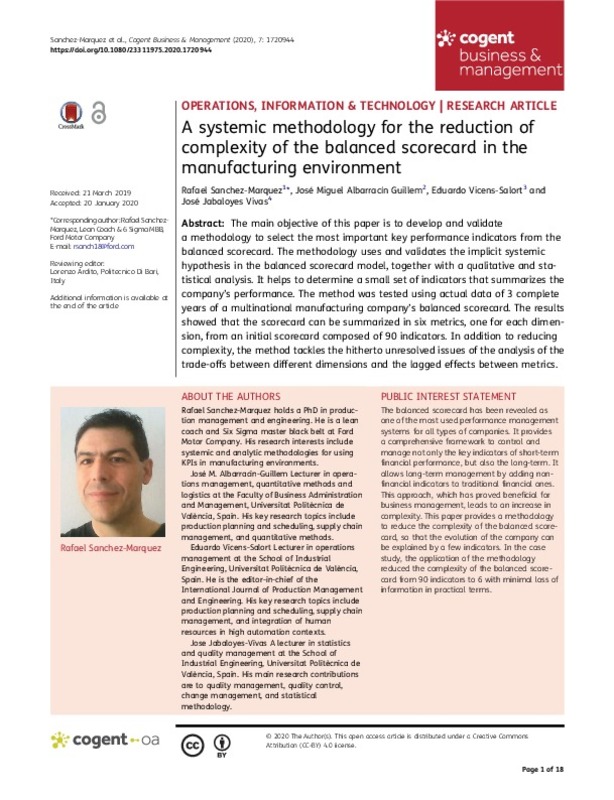Anand, M., Sahay, B. S., & Saha, S. (2005). Balanced Scorecard in Indian Companies. Vikalpa: The Journal for Decision Makers, 30(2), 11-26. doi:10.1177/0256090920050202
Banker, R. D., Chang, H., Janakiraman, S. N., & Konstans, C. (2004). A balanced scorecard analysis of performance metrics. European Journal of Operational Research, 154(2), 423-436. doi:10.1016/s0377-2217(03)00179-6
Bansal, A., Kauffman, R. J., & Weitz, R. R. (1993). Comparing the Modeling Performance of Regression and Neural Networks as Data Quality Varies: A Business Value Approach. Journal of Management Information Systems, 10(1), 11-32. doi:10.1080/07421222.1993.11517988
[+]
Anand, M., Sahay, B. S., & Saha, S. (2005). Balanced Scorecard in Indian Companies. Vikalpa: The Journal for Decision Makers, 30(2), 11-26. doi:10.1177/0256090920050202
Banker, R. D., Chang, H., Janakiraman, S. N., & Konstans, C. (2004). A balanced scorecard analysis of performance metrics. European Journal of Operational Research, 154(2), 423-436. doi:10.1016/s0377-2217(03)00179-6
Bansal, A., Kauffman, R. J., & Weitz, R. R. (1993). Comparing the Modeling Performance of Regression and Neural Networks as Data Quality Varies: A Business Value Approach. Journal of Management Information Systems, 10(1), 11-32. doi:10.1080/07421222.1993.11517988
Boj, J. J., Rodriguez-Rodriguez, R., & Alfaro-Saiz, J.-J. (2014). An ANP-multi-criteria-based methodology to link intangible assets and organizational performance in a Balanced Scorecard context. Decision Support Systems, 68, 98-110. doi:10.1016/j.dss.2014.10.002
Chytas, P., Glykas, M., & Valiris, G. (2011). A proactive balanced scorecard. International Journal of Information Management, 31(5), 460-468. doi:10.1016/j.ijinfomgt.2010.12.007
Dong, Y., & Qin, S. J. (2018). A novel dynamic PCA algorithm for dynamic data modeling and process monitoring. Journal of Process Control, 67, 1-11. doi:10.1016/j.jprocont.2017.05.002
Ferenc, A. (2011). Balanced scorecard measurement applications at a car manufacturer supplier company. https://pdfs.semanticscholar.org/f10e/409533c49dd2934ace78405126978302ab96.pdf
Fisher, R. A. (1992). Statistical Methods for Research Workers. Breakthroughs in Statistics, 66-70. doi:10.1007/978-1-4612-4380-9_6
Gans, D. J. (1981). Corrected and Extended Tables for Tukey’s Quick Test. Technometrics, 23(2), 193-195. doi:10.1080/00401706.1981.10486265
Grillo, H., Campuzano-Bolarin, F., & Mula, J. (2018). Modelling performance management measures through statistics and system dynamics-based simulation. Dirección y Organización, (65), 20-35. doi:10.37610/dyo.v0i65.526
Gurrea, V., Alfaro-Saiz, J.-J., Rodriguez, R., & Verdecho, M. J. (2014). Application of fuzzy logic in performance management: a literature review. International Journal of Production Management and Engineering, 2(2), 93. doi:10.4995/ijpme.2014.1859
Hoque, Z. (2014). 20 years of studies on the balanced scorecard: Trends, accomplishments, gaps and opportunities for future research. The British Accounting Review, 46(1), 33-59. doi:10.1016/j.bar.2013.10.003
Junior, I. C. A., Marqui, A. C. & Martins, R. A. (2008). Multiple case study on balanced scorecard implementation in sugarcane companies. http://citeseerx.ist.psu.edu/viewdoc/download?doi=10.1.1.572.3364&rep=rep1&type=pdf
Kaplan, R. S. (2009). Conceptual Foundations of the Balanced Scorecard. Handbooks of Management Accounting Research, 1253-1269. doi:10.1016/s1751-3243(07)03003-9
Ku, W., Storer, R. H., & Georgakis, C. (1995). Disturbance detection and isolation by dynamic principal component analysis. Chemometrics and Intelligent Laboratory Systems, 30(1), 179-196. doi:10.1016/0169-7439(95)00076-3
Malmi, T. (2001). Balanced scorecards in Finnish companies: A research note. Management Accounting Research, 12(2), 207-220. doi:10.1006/mare.2000.0154
Morard, B., Stancu, A. & Jeannette, C. (2013). Time evolution analysis and forecast of key performance indicators in a balanced scorecard. Global Journal of Business Research, 7(2), 9–27.
Noerreklit, H., & Schoenfeld, H.-M. W. (2000). Controlling Multinational Companies: An Attempt to Analyze Some Unresolved Issues. The International Journal of Accounting, 35(3), 415-430. doi:10.1016/s0020-7063(00)00064-9
Rodriguez, R. R., Saiz, J. J. A., & Bas, A. O. (2009). Quantitative relationships between key performance indicators for supporting decision-making processes. Computers in Industry, 60(2), 104-113. doi:10.1016/j.compind.2008.09.002
Sanchez-Marquez, R., Albarracin Guillem, J. M., Vicens-Salort, E., & Jabaloyes Vivas, J. (2018). A statistical system management method to tackle data uncertainty when using key performance indicators of the balanced scorecard. Journal of Manufacturing Systems, 48, 166-179. doi:10.1016/j.jmsy.2018.07.010
Sánchez Márquez, R., Albarracín Guillem, J. M., Vicens-Salort, E., & Jabaloyes Vivas, J. (2018). Intellectual Capital and Balanced Scorecard: impact of Learning and Development Programs using Key Performance Indicators in Manufacturing Environment. Dirección y Organización, (66), 34-49. doi:10.37610/dyo.v0i66.534
Verdecho, M.-J., Alfaro-Saiz, J.-J., & Rodriguez-Rodriguez, R. (2014). A Performance Management Framework for Managing Sustainable Collaborative Enterprise Networks. Lecture Notes in Computer Science, 546-554. doi:10.1007/978-3-662-44745-1_54
Walczak, S., & Cerpa, N. (1999). Heuristic principles for the design of artificial neural networks. Information and Software Technology, 41(2), 107-117. doi:10.1016/s0950-5849(98)00116-5
[-]









